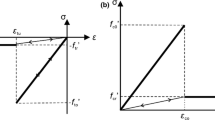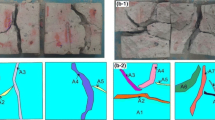Abstract
Shale gas has been discovered in the Upper Triassic Yanchang Formation, Ordos Basin, China. Due to the weak tectonic activities in which the shale plays, core observations indicate abundant random non-tectonic micro- fractures in the producing shales. The non-tectonic micro-fractures are different from tectonic fractures and are characterized by being irregular, curved, discontinuous, and randomly distributed. The role of micro-fractures in hydraulic fracturing for shale gas development is currently poorly understood yet potentially critical. Two-dimensional computational modeling studies have been used in an initial attempt toward understanding how naturally random fractured reservoirs respond during hydraulic fracturing. The aim of the paper is to investigate the effect of random non-tectonic fractures on hydraulic fracturing. The numerical models with random non-tectonic micro-fractures are built by extracting the fractures of rock blocks after repeated heating and cooling, using a digital image process. Simulations were conducted as a function of: (1) the in-situ stress ratio; (2) internal friction angle of random fractures; (3) cohesion of random fractures; (4) operational variables such as injection rate; and (5) variable injection rate technology. A sensitivity study reveals a number of interesting observations resulting from these parameters on the shear stimulation in a natural fracture system. Three types of fracturing networks were observed from the studied simulations, and the results also show that variable injection rate technology is most promising for producing complex fracturing networks. This work strongly links the production technology and geomechanical evaluation. It can aid in the understanding and optimization of hydraulic fracturing simulations in naturally random fractured reservoirs.
Similar content being viewed by others
References
Biot M A. 1941. General theory of three-dimensional consolidation. J Appl Phys, 12: 155–164
Bruno M S, Nakagawa F M. 1991. Pore pressure influence on tensile fracture propagation in sedimentary rock. Int J Rock Mech Min Sci, 28: 261–273
Cipolla C L, Lolon E P, Erdie J C, Tathed V S. 2009a. Modeling well performance in shale-gas reservoirs. In: The SPE/EAGE Reservoir Characterization and Simulation Conference. Abu Dhabi, UAE, October 19–21
Cipolla C L, Lolon E P, Mayerhofer M J. 2009b. Reservoir modeling and production evaluation in shale-gas reservoirs. In: International Petroleum Technology Conference. Doha, Qatar, 7–9 December
Curtis J B. Fractured shale-gas systems. 2002. AAPG Bull, 86: 1921–1938
Ding W L, Xu C C, Jiu K. 2011. The research process of shale fracture. Adv Earth Sci, 2: 135–145
Ding W L, Zhang B W, Li T M. 2003. Formation of non-tectonic fractures in mudstones in Gulong Depression. Oil Gas Geol, 24: 50–54
Gale J F W, Holder J. 2008). Natural fractures in the Barnett shale: Constraints on spatial organization and tensile strength with implications for hydraulic fracture treatment in shale-gas reservoirs. San Francisco: The 42nd U. S. Rock Mechanics Symposium (USRMS). CA, June 29–July 2
Gale J F W, Laubach S E, Olson J E, Eichhubl P, Fall A. 2014. Natural fractures in shale: A review and new observations. AAPG Bull, 98: 2165–2216
Hou B, Chen M, Cheng W, Tan P. 2014. Fracture mechanism on shale gas reservoir fracturing with variable pump rate (in Chinese). Chin J Geotech Eng, 36: 2149–2152
Jaeger J C, Cook N G. 1979. Fundamentals of Rock Mechanics. 3rd ed. London: Chapman & Hall
Jeffrey R G, Zhang X, Bunger A P. 2010. Hydraulic fracturing of naturally fractured reservoirs. In: Proceedings of the 35th Workshop on Geothermal Reservoir Engineering. Stanford, California, USA, 1–3, February
King G E. 2010. Thirty years of gas shale fracturing: What have we learned? In: The SPE Annual Technical Conference and Exhibition. Florence, Italy, 19–22 September. Paper SPE 133456
Kresse O, Cohen C, Weng X, Wu R, Gu H. 2011. Numerical modeling of hydraulic fracturing in naturally fractured formations. In: The 45th US Rock Mechanics Symposium. San Francisco, California, USA, 26–29 June. Paper ARMA 11–363
Kresse O, Weng X, Gu H, Wu R. 2013. Numerical modeling of hydraulic fractures interaction in complex naturally fractured formations. Rock Mech Rock Eng, 46: 555–568
Lei Y H, Luo X R, Wang X Z. 2015. Characteristics of silty laminae in Zhangjiatan Shale of southeastern Ordos Basin, China: Implications for shale gas formation. AAPG Bull, 99: 661–687
Nagel N, Sanchez-Nagel M. 2011. Stress shadowing and microseismic events: A numerical evaluation. In: The SPE Annual Technical Conference and Exhibition, Denver, Colorado, USA, 30 October–2 November. SPE 152192. Paper SPE 147363
Noghabai K. 1999. Discrete versus smeared versus element-embedded crack models on ring problem. J Eng Mech, 125: 307–315
Palmer I D, Luiskutty C T. 1985. A model of the hydraulic fracturing process for elongated vertical fractures and comparisons of results with other models. In: The SPE/DOE Low Permeability Gas Reservoirs Symposium. Denver, Colorado, 19–22 May. Paper SPE 13864
Palmer I, Moschovidis Z. 2010. New method to diagnose and improve shale gas completions. In: The SPE Annual Technical Conference and Exhibition. Florence, Italy, 19–22 September. Paper SPE 134669
Perkins T K, Kern L R. 1961. Widths of hydraulic fractures. JPT, 13: 937–949
Simonson E R, Abou-Sayed A S, Clifton J J. 1978. Containment of massive hydraulic fractures. SPE J, 18: 27–32
Tang C A, Tham L G, Lee P K K, Yang T H, Li L C. 2002. Coupled analysis of flow, stress and damage (FSD) in rock failure. Int J Rock Mech Min Sci, 39: 477–489
Tang X, Zhang J C, Wang X Z. 2014. Shale characteristics in the southeastern Ordos Basin, China: Implications for hydrocarbon accumulation conditions and the potential of continental shales. Int J Coal Geol, 128: 32–46
Terzaghi K. 1936. The shearing resistance of saturated soils and the angle between the planes of shear. In: International Conference on Soil Mechanics and Foundation Engineering. Cambridge: Harvard University Press. 54–56
Thallak S, Rothenbury L, Dusseault M. 1991. Simulation of multiple hydraulic fractures in a discrete element system. In: Roegiers J C, ed. Rock Mechanics as a Multidisciplinary Science. In: Proceedings of the 32nd US Symposium. Balkema, Rotterdam. 271–280
Voegele M D, Abou-Sayed A S, Jones A H. 1983. Optimization of stimulation design through the use of in-situ stress determination. JPT, 35: 1071–1081
Wang Y, Li X, Zhou R Q, Zheng B, Zhang B, Wu Y F. 2015. Numerical evaluation of the effect of fracture network connectivity in naturally fractured shale based on FSD model. Sci China Earth Sci, doi: 10.1007/s11430-015-5164-9
Wang S Y, Sloan S W, Liu H Y. 2011. Numerical simulation of the rock fragmentation process induced by two drill bits subjected to static and dynamic (impact) loading. Rock Mech Rock Eng, 44: 317–336
Warpinski N R, Fnley S J, Vollendorf W C. 1982. The interface test series: An in-situ study of factors affecting the containment of hydraulic fractures. Sandia National Laboratories Report, SAND. 2381–2408
Warpinski N R, Waltman C K, Du J. 2009. Anisotropy Effects in Microseismic Monitoring. In: The SPE Annual Meeting and Exhibition. New Orleans, LA, USA, 4–7 October. Paper SPE 124208
Yang T H, Tang C A, Zhu W C, Feng Q Y. 2001. Coupling analysis of seepage and stress in rock failure process (in Chinese). Chin J Rock Soil Eng, 23: 489–493
Zhou J, Jin Y, Chen M. 2010. Experimental investigation of hydraulic fracturing in random naturally fractured blocks. In J Rock Mech Min Sci, 47: 1193–1199
Zhu D W. 2013. Developmental characteristics, major regulating factors and distribution prediction of fractures in shale of Upper Triassic Yanchang formation in Yanchang oil-gas field. Master Degree. Wuhan: China University of Geosciences. 45–53
Author information
Authors and Affiliations
Corresponding author
Rights and permissions
About this article
Cite this article
Wang, Y., Li, X., Zhao, Z. et al. Contributions of non-tectonic micro-fractures to hydraulic fracturing—A numerical investigation based on FSD model. Sci. China Earth Sci. 59, 851–865 (2016). https://doi.org/10.1007/s11430-015-5232-1
Received:
Accepted:
Published:
Issue Date:
DOI: https://doi.org/10.1007/s11430-015-5232-1




